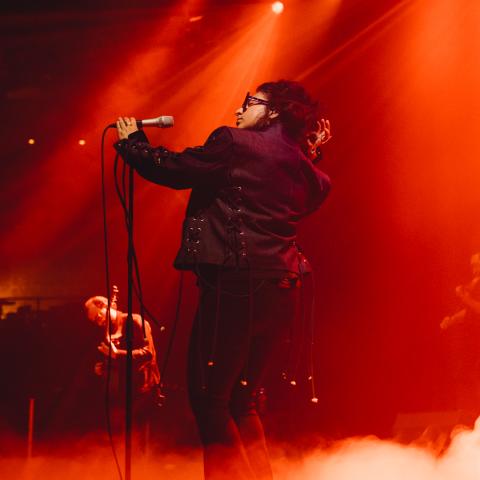In the Spotlight: Singer’s Robots

Eric Singer
Pittsburgh, PA, has undergone an economic boom thanks to its high-tech and robotics industries that it has earned the nickname “Robot City.” Thus it was the perfect location for Eric Singer '91 to launch Singerbots (singerbots.com), a successful enterprise that blends the fields of music and robotics in fascinating ways. For more than 20 years, Singer has been a leader in this area and he credits Berklee with increasing his curiosity.
“My mentor at Berklee was Richard Boulanger who got me into creating alternative musical instruments out of unconventional materials like plastic tubes and gloves,” he recalls. Boulanger, for whom Singer worked as an assistant after graduating, suggested he pursue graduate studies at New York University. “When I got there my mission was to study computer science, and I ended up spending a lot of time in the school’s multimedia lab where I got a chance to do interactive music programming.” This led him to robotic musical instruments.
From there, Singer went off on his own, collaborating with other musical artists who were also interested in robotics. In 2000 he started the League of Electronic Musical Urban Robots, or LEMUR, a collective of artists and technologists, for the purpose of creating robotic musical instruments. “Even though I had a bachelor’s degree from Carnegie Mellon in electromechanical engineering, I really had zero experience in robotics. There was a ton of experimentation,” Singer concedes. “With LEMUR I knew I could fill my knowledge gaps by working with others who had those skills.” Within the first year of operation, Singer had secured funding for machines and raw materials via a Rockefeller Foundation grant, and they were off and running. The group initially conceived and built machines for five separate artists, each with different needs.
His first ambition was to build a robotic guitar he called the Guitarbot, which took two years to design and complete. Once LEMUR had produced a small handful of instruments, they began showing them in public at art galleries, public performances, and the like. “People were fascinated,” he recalls. “At the time, the idea of robotic musical instruments was very novel. All kinds of incredible ideas were buzzing around LEMUR. The results were really cool and generated highly musical results.”
All of Singer’s robotic creations are MIDI-driven. Musical commands are transmitted via circuits and software that he designed that convert MIDI into mechanical signals. “From the performer’s perspective they’re built to be user-friendly. They can be controlled by any MIDI-controlled synthesizer,” Singer explains.
Singer’s work caught the attention of guitarist/composer Pat Metheny H’96. Metheny contacted him in 2008, interested in having a set of instruments built so that he could tour as a solo artist accompanied by a robotic backing band. Called the Orchestrion Project, the tour paid tribute to the 19th-century musical machines of the same name while incorporating modern robotic technology. “We were possibly the only group in the world that could build a project on such a scale,” Singer states. Metheny needed a robotic orchestra that was both massive and reliable, and in 2010 he took the Orchestrion on a yearlong worldwide tour. “We sent one person with a truck to set up the instruments. Pat would play a three-hour show, then our tech would tear it down, pack it up and drive it to the next gig. At the end of the tour I asked him how the instruments performed and he said, ‘They were the least of my problems!’”
The reliability of the instruments is Singer’s first priority—especially on his latest project. He has created a robotic orchestra installation for the Lido Cabaret in Paris, France, which will run for 10 years without Singer’s assistance. “The exciting thing about these instruments is that they’re creating real-time acoustic sounds, and the mechanics provide a great visual element too,” Singer notes.
“No matter how complex the technology becomes, the human musical element is what’s most important,” he says. Nearly every installation he’s done is interactive in some way. “I’ve never woken up to find that these robots have created music on their own,” he says. “It’s up to the composers and performers who use these tools to bring their visions to life.”




